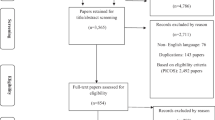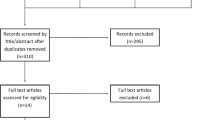Abstract
Background
Excessive gambling is a prominent Public Health problem with high prevalence rates in many countries. Substance abuse and other co-morbidities often constitute a major health hazard for the person which gambles with a loss of material and social resources, as well as being a major concern for his or her significant others. The present study updates and extends prevalence data to include work published between 2000 and 2005 in English and other European languages.
Methods
In a three-step search and exclusion process, studies with current adult prevalence rates were gathered.
Results
Almost all studies fulfil basic research standards. The weighted mean prevalence rates for excessive gambling (problem and pathological) are 3.0% for the South Oaks Gambling Survey (problem 1.2%; pathological 1.8%), 3.3% for the Canadian Problem Gambling Index (problem 2.4%; pathological 0.8%) and 3.1% for the DSM-IV (problem 1.9%; pathological 1.2%).
Conclusion
The prevalence rates are comparable and relatively stable between countries and across survey instruments, and do not differ from earlier reviews. The regular epidemiological monitoring of excessive gambling remains a major Public Health issue although the distinction between pathological and problem gambling is not appropriate for epidemiological research. Further studies are needed with respect to concomitant lifestyle characteristics.
Similar content being viewed by others
References
Abbott, M., & McKenna, B. G. (2000). Gambling and problem gambling among recently sentenced women prisoners in New Zealand. The Department of Internal Affairs. Available from: URL: www.dia.govt.nz.
Abbott, M. W., & Volberg, R. A. (2000). Taking the pulse on gambling and problem gambling in New Zealand: A report on phase one of the 1999 national prevalence survey. The Department of Internal Affairs. Available from: URL: www.dia.govt.nz.
Abbott, M., McKenna, B. G., & Giles, L. C. (2000). Gambling and problem gambling among recently sentenced males in four New Zealand prisons. The Department of Internal Affairs. Available from: URL: www.dia.govt.nz.
Abbott, M. W., Volberg, R. A., & Ronnberg S. (2004). Comparing the New Zealand and Swedish national surveys of gambling and problem gambling. Journal of Gambling Studies, 20(3), 237–258.
American Psychiatric Association. (1994). Diagnostic and Statistical Manual of Mental Disorders. Fourth Edition. Washington, DC.
Australian Institute for Gambling Research (AIGR). (2001). Survey of the nature and extent of gambling and problem gambling in the ACT. The ACT Gambling and Racing Commission. Available from: URL: www.gamblingandracing.act.gov.au.
Biganzoli, A., Capelli, M., Capitanucci, D., Smaniotto, R., & Alippi, M. (2004). Indagine sui comportamenti di gioco d’azzardo in provincia di Pavia. Il gioco nel territorio. [An investigation into pathological gambling. Epidemiological study of gambling attitudes and prevalence of pathological gambling in the Pavia province (Italy)]. Casa Editrice DREAM.
Blaszczynski, A., & Steel, Z. (1998). Personality disorders among pathological gamblers. Journal of Gambling Studies, 14(1), 51–71.
Boardman, B., Jones, J., Perry, J., & Wood, M. (2003). Compulsive gambling in Kentucky. Leglisative Research Commission. Available from: URL: www.lrc.ky.gov.
Bondolfi, G., Osiek, C., & Ferrero, F. (2000). Prevalence estimates of pathological gambling in Switzerland. Acta Psychiatrica Scandinavica, 101(6), 473–475.
Cox, B. J., Yu, N., Afifi, T. O., & Ladouceur, R. (2005). A national survey of gambling problems in Canada. Canadian Journal of Psychiatry, 50(4), 213–217.
Crockford, D. N., & El-Guebaly, N. (1998). Psychiatric comorbidity in pathological gambling: A critical review. Canadian Journal of Psychiatry, 43(1), 43–50.
Cunningham-Williams, R. M., Cottler, L. B., Compton, W. M., & Spitznagel, E. L. (1998). Taking chances: Problem gamblers and mental health disorders. Results from the St. Louis epidemiologic catchment area study. American Journal of Public Health, 88(7), 1093–1096.
Cunningham-Williams, R. M., & Cottler, L. B. (2001). The epidemiology of pathological gambling. Seminars in Clinical Neuropsychiatry, 6(3), 155–166.
Ferris, J., & Wynne, H. (2001). The Canadian Problem Gambling Index: Final report. Canadian Centre for Substance Abuse. Available from: URL: www.ccsa.ca.
Focal Research Consultants. (2001). Survey of gambling and problem gambling in New Brunswick. New Brunswick Department of Health and Wellness. Available from: URL: www.gnb.ca.
Götestam, K. G., & Johansson, A. (2003). Characteristics of gambling and problematic gambling in the Norwegian context. A DSM-IV based telephone interview study. Addictive Behaviors, 28(1), 189–197.
Gullickson, A. R., & Hartmann, D. (2001). A survey of gambling behaviors in Michigan, 2001. Report to The Michigan Department of Community Health. The Michigan Department of Community Health. Available from: URL: www.wmich.edu.
Hing, N., & Breen, H. (2002). A profile of gaming machine players in clubs in Sydney, Australia. Journal of Gambling Studies, 18(2), 185–205.
Korn, D. A., & Shaffer, H. J. (1999). Gambling and the health of the public: Adopting a Public Health perspective. Journal of Gambling Studies, 15(4), 289–365.
Ladouceur, R., Jacques, C., Chevalier, S., Sévigny, S., Hamel, D., & Allard, D. (2004). Prévalence des habitudes de jeu et du jeu pathologique au Québec en 2002 [Prevalence of gambling habits and problem gambling in Québec 2002]. Québec et Montréal: Université Laval et Institut national de santé public du Québec.
Lepage, C., Ladouceur, R., & Jacques, C. (2000). Prevalence of problem gambling among community service users. Community Mental Health Journal, 36(6), 597–601.
Lesieur, H. R., & Blume, S. B. (1987). The South Oaks Gambling Screen (SOGS)— -A new instrument for the identification of pathological gamblers. American Journal of Psychiatry, 144(9), 1184–1188.
Lesieur, H. R., & Blume, S. B. (1990). Characteristics of pathological gamblers identified among patients on a psychiatric admissions service. Hospital & Community Psychiatry, 41(9), 1009–1012.
Lund, I., & Nordlund, S. (2003). Pengespill og pengespillproblemer i norge [Gambling and problem gambling in Norway]. Oslo: SIRUS. Available from: URL: http://www.sirus.no.
Marshall, K., & Wynne, H. (2003). Fighting the odds. Perspectives on labour and income. Statistic Canada, 12(4), 5–13.
Miller, M. A. R. M., & Westermeyer, J. M. (1996). Gambling in Minnesota. American Journal of Psychiatry, 153(6), 845.
Ministry of Public Safety and Solicitor General. (2003). British Columbia problem gambling prevalence study. Ministry of Public Safety and Solicitor General. Available from: URL: www.pssg.gov.bc.ca.
Ministry of Community Development YaS. (2005). More than half of Singapore gambles; But only 2 in 100 at risk of gambling addiction. Ministry of Community Development. Available from: URL: www.mcys.gov.sg.
Molo Bettelini, C., Alippi, M., & Wernli, B. (2000). Il gioco patologico in Ticino: uno studio epidemiologico [An investigation into pathological gambling]. Mendrisio: Centro di documentazione e ricerca OSC.
Orford, J., Sproston, K., Erens, B., White, C., & Mitchell, L. (2003). Gambling and problem gambling in Britain. Brunner-Routledge, East Susssex.
Patton, D., Brown, D., Dhaliwal, D., Pankratz, K., & Broszeit, B. (2002). Gambling involvement and problem gambling in Manitoba. Addictions Foundation of Manitoba. Available from: URL: www.afm.mb.ca.
Queensland Government (2002) Queensland Household Gambling Survey 2001. Office of the Government Statistician. Available from: URL: www.nla.gov.au/nla.arc-51569.
Raylu, N., & Oei, T. P. (2002). Pathological gambling. A comprehensive review. Clinical Psychology Review, 22(7), 1009–1061.
Rihs-Middel, M., Roberts, G., & Winer, J. (2006). Experimental studies of acute alcohol intake and aggression: a meta-analysis. (in print).
Rihs, M., Andronicos, M., Stucki, S., Stach, M., Simon, O., Aufrère, L., et al. (2006). "Vulnérabilité par rapport au jeu de hasard et d'argent: Implications pour la prévention." Recherches de l'OFSP en matière de dépendances 2002-03 - Volume 2/3: Prévention. Ed. Office fédéral de la santé publique. Bern: Office fédéral de la santé publique, 2006. 113–120.
Schofield, G., Mummery, K., Wang, W., & Dickson, G. (2004). Epidemiological study of gambling in the non-metropolitan region of central Queensland. Australian Journal of Rural Health, 12(1), 6–10.
Schrans, T., & Schellinck, T. (2004). 2003 Nova Scotia gambling prevalence study. Nova Scottia Office of Health Promotion. Available from: URL: www.gov.ns.ca.
Shaffer, H. J., Hall, M. N., & Vander, B. J. (1999). Estimating the prevalence of disordered gambling behavior in the United States and Canada: A research synthesis. American Journal of Public Health, 89(9), 1369–1376.
Shaffer, H. J., & Hall, M. N. (2001). Updating and refining prevalence estimates of disordered gambling behaviour in the United States and Canada. Canadian Journal of Public Health. Revue Canadienne de Santé Publique, 92(3), 168–172.
Shaffer, H. J., & Kidman, R. (2004). Gambling and the public health. In J. E. Grant, M. N. Potenza (Eds.), Pathological Gambling. A clinical guide to treatment. Washington, D.C., London, England: American Psychiatric Publishing, Inc.
Shapira, N. A., Ferguson, M. A., Frost-Pineda, K., & Gold, M. S. (2002). Gambling and problem gambling prevalence among adults in Florida. A Report to the Florida Council on Compulsive Gambling, Inc.
Slutske, W. S., Eisen, S., True, W. R., Lyons, M. J., Goldberg, J., & Tsuang, M. (2000). Common genetic vulnerability for pathological gambling and alcohol dependence in men. Archives of General Psychiatry, 57(7), 666–673.
Smart, R. G., & Ferris J. (1996). Alcohol, drugs and gambling in the Ontario adult population, 1994. Canadian Journal of Psychiatry—Revue Canadienne de Psychiatrie, 41(1), 36–45.
Smith, G. J., & Wynne, H. (2002). Measuring gambling and problem gambling in Alberta. Using the Canadian Problem Gambling Index (CPGI). Alberta Gaming Research Institute. Available from: URL: www.uofaweb.ualberta.ca.
Vogel, R. J., & Ardoin P. (2002). Gambling in Louisiana. 2002 Louisiana study of problem gambling. Office for Addictive Disorders. Available from: URL: www.dhh.state.la.us.
Volberg, R. A. (1994). The prevalence and demographics of pathological gamblers: Implications for Public Health. American Journal of Public Health, 84(2), 237–241.
Volberg, R. A. (2001a). Changes in gambling and problem gambling in Oregon: Results from a replication study, 1997 to 2000. Northampton, MA: Gemini Research Inc.
Volberg, R. A. (2001b). Gambling and problem gambling in North Dakota: A replication study, 1992 to 2000. Report to the North Dakota Office of the Governor. Gemini Research. Available from: URL: www.state.nd.us.
Volberg, R. A., Abbott, M. W., Ronnberg, S., & Munck, I. M. (2001). Prevalence and risks of pathological gambling in Sweden. Acta Psychiatrica Scandinavica, 104(4), 250–256.
Volberg, R. A. (2002). Gambling and problem gambling in Nevada. Report to the Nevada Department of Human Resources. Gemini Research. Available from: URL: www.hr.state.nv.us.
Volberg, R. A. (2003). Gambling and problem gambling in Arizona. Report to the Arizona Lottery. Gemini Research. Available from: URL: www.problemgambling.az.gov.
Welte, J., Barnes, G. M., Wieczorek, W. F., Tidwell, M. C., & Parker, J. (2001). Alcohol and gambling pathology among U.S. adults: Prevalence, demographic patterns and comorbidity. Journal of Studies on Alcohol, 62(5), 706–712.
Welte, J., Barnes, G. M., Wieczorek, W. F., Tidwell, M. C., & Parker J. (2002). Gambling participation in the U.S. Results from a national survey. Journal of Gambling Studies, 18(4), 313–337.
Wiebe, J., Single, E., & Falkowski-Ham, A. (2001). Measuring gambling and problem gambling in Ontario. Responsible Gambling Council. Available from: URL: www.responsiblegambling.org.
Wong, I. L., & So, E. M. (2003). Prevalence estimates of problem and pathological gambling in Hong Kong. American Journal of Psychiatry, 160(7), 1353–1354.
Wynne, H. (2002). Gambling and problem gambling in Saskatchewan. Canadian Centre on Substance Abuse. Available from: URL: www.health.gov.sk.ca.
Acknowledgments
The present study has benefited from the support of many people and institutions. We wish to thank Jacques Besson, Laurence Aufrère, and Olivier Simon from the Centre for Excessive Gambling. Our gratitude is extended to Ronnie and Charles Blakeney, for their helpful comments and to all the others who contributed to this text for their valuable support. The authors received financial support for completing this study from the Department of Psychiatry of the University Hospital, Lausanne, Switzerland.
Author information
Authors and Affiliations
Corresponding author
Rights and permissions
About this article
Cite this article
Stucki, S., Rihs-Middel, M. Prevalence of Adult Problem and Pathological Gambling between 2000 and 2005: An Update. J Gambl Stud 23, 245–257 (2007). https://doi.org/10.1007/s10899-006-9031-7
Received:
Accepted:
Published:
Issue Date:
DOI: https://doi.org/10.1007/s10899-006-9031-7




